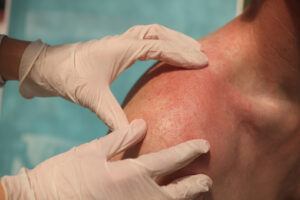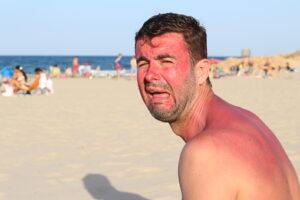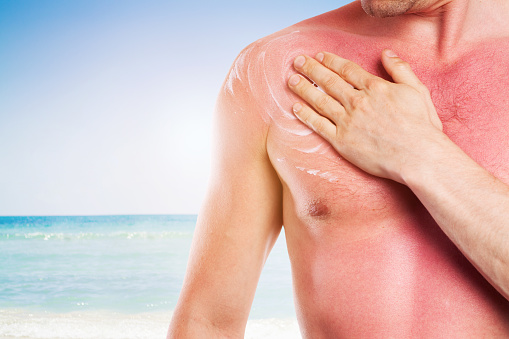A great day can instantly turn sour once you notice discomfort on your face. It could be pain, itchiness, redness, or swelling on any part of your face, and it can be really uncomfortable. When this happens, one of the questions you begin to ask yourself is, “how long will this sunburn last?” Well, that is what we want to uncover. In this article, we’ll be answering the frequently asked question; “how long does a sunburn last?” We’ll also be sharing tips on what to do to make sunburns heal faster.

But first, what exactly is a Sunburn?
Sunburn is the resulting damage to the skin due to overexposure to ultraviolet (UV) rays of the sun. Basically, it is any reaction you get on your skin after staying out in the sun for too long.
There are two types of ultraviolet (UV) rays that we come in contact with in our atmosphere: UVA and UVB. UVA has a longer wavelength than UVB, and because of this, it penetrates the deeper layers of our skin.
These two types of UV rays cause sunburn and even more permanent damages like wrinkles, skin discoloration, and other signs of premature aging. When you get exposed to the sun more than it’s considered healthy, your skin suffers the consequences. And one of those consequences is the sunburn you feel.
SYMPTOMS OF A SUNBURN
What does a sunburn feel like? — you may ask. Your sunburn experience can be different from someone else’s. And there are certain factors that contribute to the severity of a sunburn. These factors include:
- Skin type and skin tone
- The amount of time spent in the sun
- The type and amount of protection used against the sun exposure
- The amount of sun exposure
The above factors contribute to the symptoms of sunburn and how it would feel on your skin. By the way, don’t be surprised if you get a sunburn on a cloudy day. Studies have shown that 90% of sun rays pass through white clouds. So if you don’t protect yourself, you can easily get sunburnt even on a cloudy day.
The following are the signs and symptoms of sunburn:
- Redness or pinkness of skin tone
- Pain in specific areas of the face
- Swelling
- Skin feels hot or warm when touched
- Small fluid blisters on the skin
- Itchy skin
- In extreme cases, headache, nausea, fever, and fatigue
- Rashes, peeling, flakiness
- Pain in the eyes
Aside from the face, other body parts like the earlobes, lips, and scalp can also get sunburnt. In fact, your body can get burnt if it isn’t properly covered with clothes that are thick enough. Our eyes are not left out because they’re also very sensitive to ultraviolet radiation.
In most cases, you start feeling sunburn about 4 hours after sun exposure. But you can only determine the severity of the sunburn after observing for a day or more. The healing time is what varies.
HOW LONG DOES A SUNBURN LAST?
Sunburns don’t have a specific timeframe. They can last for days to weeks, depending on how severe they are.
Mild sunburns, where you only have slight skin redness, take the shortest time to heal— between 3-5 days. But with a moderate sunburn, where the skin is hot to touch and slightly swollen, it can take about a week for it to heal completely.
The swelling from sunburns often heals within two days. Although, in severe cases, it can be more than that. Aloe Vera gel products can be used to quicken the healing process as it has a long history of soothing sores and sunburns.
With a severe sunburn, where the skin is very hot and swollen with blisters, it can take up to two weeks for the healing process to be complete. In extreme cases, you may experience skin poisoning. That is when you begin to have headaches, fever, and nausea.
These kinds of severe cases usually require medical attention. They take the longest time to heal and even more time for skin repair and peeling.
Once your notice peeling in your skin, it is a sign that your sunburn is healing. However, you can only be sure it is completely healed once the skin naturally sheds. This means that you have to allow the peeling to happen without any interference on your part.
Refrain from picking or shedding the skin once you notice signs of peeling or flaking. For mild and moderate cases, sunburn’s peeling phase usually lasts 2-3 days. In severe cases, it can take up to a week.
You can take warm baths to quicken the peeling process. It will also help if you apply a gentle moisturizer.

HOW TO GET YOUR SUNBURN TO HEAL FASTER
You can allow the healing process to unfold naturally, but if you find sunburns very uncomfortable, we’re sure you’ll want the experience to pass as quickly as possible. That is the purpose of this section.
Although sunburns heal after a couple of days, a few sun-smart tips can help your skin heal faster.
- Avoid the sun: This one is only natural. You can’t expect your sunburn to heal quickly if you keep exposing yourself to ultraviolet light. Stay under shades, and wear protective coverings on the sunburnt area of the body.
- Apply Aloe Vera Gel: Aloe Vera Gel has long been known for its soothing properties on injuries and burns, including sunburns. You can get the gel naturally from the plant itself. But if you can’t, getting an aloe vera gel product is just as effective.
- Apply aftersun creams: An aftersun cream is great for replenishing the skin after sun exposure. They soothe the skin and promote quicker skin healing. Hydrocortisone creams also help to manage pain, irritation, and swelling.
- Drink lots of water: It’s as simple as it sounds. Sunburns take away moisture from your skin, so drinking water helps regain and maintain hydration.
- Use water: Find ways to replenish the sunburn areas with water. You can take cool baths or try a cold compress— but not directly on the sunburnt area. Doing this may help reduce inflammation and skin hotness.
HOW TO PREVENT SUNBURNS
Prevention is better than cure, they say. It is true. Doing the right things before and after going out can help prevent sunburn. It doesn’t matter the weather—even on cool, hazy, and cloudy days— take caution every time.
- Avoid sun exposure between 10 am to 4 pm: These are the times when the sun comes out in full force; it can be particularly intense. You don’t want to be outside at these times, as you’re more likely to be sunburnt than any other time. If you have to be outside, seek shade as much as possible.
- Always wear sunscreen: The importance of sunscreen cannot be overemphasized. You must have heard this advice countless times already, but we’re saying it again. Apply water-resistant sunscreen with an SPF of 30 or more. Also, it should have broad-spectrum protection against UVA and UVB. 15-20 minutes before stepping out, apply generously on your face and other areas of your body that’ll be exposed to the sun. Apply every two hours at intervals after sweating too.
- Cover up: As long as you’re outside, cover up as much as possible. Wear a hat to protect your face, sunglasses to protect your eyes, and clothes that cover your hands and legs. Be as thorough as you can.
- Be aware of your medications: Some drugs like ibuprofen, antibiotics, etc., can make the skin more sensitive to UV light. Be aware of this effect, and talk to your pharmacist and doctor about the medications you take.

DANGERS OF SUNBURN
The more exposed you are to the sun, the more your chances of getting sunburnt, and the higher the risk of other severe skin damage and diseases. Here are a few of such severe skin damages and diseases:
- Premature skin aging: Overexposure to sunlight and repeated sunburns can quicken your skin aging process. This would cause your skin to change and make you look older than you are. These sun-induced changes are called “photoaging.” Signs of photoaging include deep wrinkles and fine lines, dry and rough skin, freckles, skin discoloration, etc.
- Skin cancer: Ultraviolet rays from the sun are the prevalent cause of skin cancer, such as melanoma. In fact, sunburns from childhood and teenage years increase your chance of skin cancer later in life. That’s how serious it is. Cases of skin cancer have been found to develop majorly in areas of the body that mostly gets exposed to sunlight. These areas include the face, scalp, lips, neck, ear, chest, legs, back, hands, and arms.
- Eye damage: Exposure to sunlight can hurt your eyes. Too much ultraviolet light negatively affects the retina, cornea, and lens. It can also lead to clouding of the lens, a condition medically known as a cataract. Sunburned eyes may also feel painful and gritty.
CONCLUSION
Sunburns, as measly as they may seem, are very uncomfortable and subsequently dangerous to our health. Who would have thought that forgetting to put on sunscreen one day can lead to sunburn, which can eventually lead to cancer of the skin?
It is only best that we try as much as possible to avoid getting sunburnt. And with all the information you’ve just gotten from this article, it shouldn’t be so difficult to do. It is also important to seek medical attention from your doctor if you notice any severity in your sunburn case.
The tips in this article definitely can’t heal your sunburns immediately, but they would make them less uncomfortable as you go through the natural healing process.

